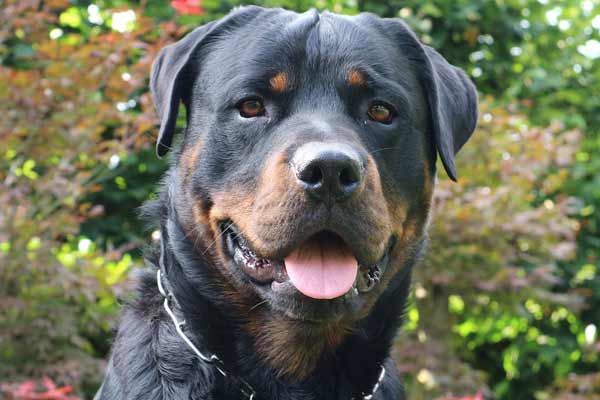If you’re a Rottweiler owner or interested in getting one, this guide is for you. We present the top nine Dogs That Look Like Rottweilers, including Miniature Pinschers, Manchester Terriers, Beaucerons, Dobermans, Hovawarts, Cane Corsos, Pit Bull Terriers, Greater Swiss Mountain Dogs, and Mastiffs.
While smaller options like the Miniature Pinscher and Manchester Terrier resemble Rottweilers, breeds like the Beauceron and Hovawart closely match size, body type, and color.
Rottweilers are known for their origins in Germany and were used initially as butcher’s dogs. They are large, impressive dogs with a commanding presence, distinctive black and tan coloration, and robust physical traits.
Discover their origins, sizes, colors, and physical traits. We also answer common questions about miniature Rottweilers and mixed breeds. Join us on this visual journey to find the perfect Rottweiler look-alike for your family.
9 Dogs That Look Like Rottweiler
Here is your reference point for the standard Rottweiler. All dogs are black and tan and have a stereotypical rust or mahogany marking pattern. You can appreciate the natural and docked tails of various individuals.
Finally, you can see the powerful broad chest unique to the breed. Each dog has a watchful expression, bounding athleticism, and a pronounced stop between head and snout.
Is There Such a Thing as a Miniature Rottweiler?
With the explosion of designer dogs and the move towards smaller dogs to better fit tight quarters, you may wonder about a miniature version of a Rottweiler. While the smallest Rottie is likely well over 50 pounds, some breeds will garner a double-take.
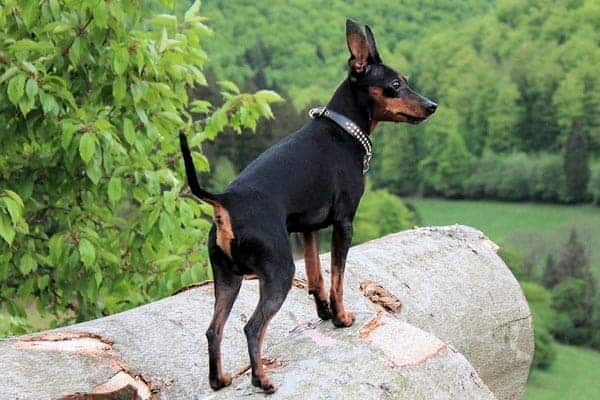
Miniature Pinscher
With cropped ears, a Min Pin more closely resembles the Doberman than the Rottweiler. However, the Miniature Pinscher with natural ears is one of the closest breeds you will get to a mini Rottie.
Min Pins are lively and intelligent dogs with a characteristic hackney-like gait. They are refined without appearing delicate in their sturdy and compact frames. Their ears are cropped in the US, so they stand up and have docked tails.
- Country of Origin: Germany
- History: Likely bred from German Pinschers to hunt rats and other vermin; Infusions of Dachshund and Italian Greyhound
- Size: 10 to 12.5 inches tall, weigh 8 to 11 pounds
- Colors: Solid red or stag red (Some interspersed black hairs), black and tan (marked like a Rottie), or chocolate and tan (Liver is the result of a recessive gene that suppresses black)
You can see how the Min Pin is more similar to the Dobie than the Rottie.
However, even though both dogs have cropped ears, notice how different their faces are, revealing their family trees separated immediately from the German Pinscher and each other.
Markings are very like those of the Rottweiler.
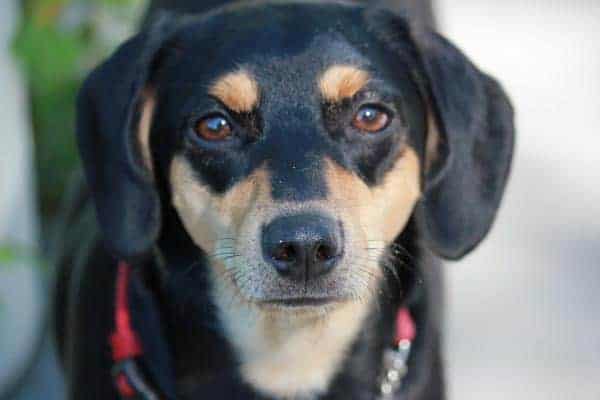
Manchester Terrier
Like the Min Pin, the Manchester Terrier is not closely related to the Rottie or the Miniature Pinscher.
Manchester is a spirited companion with a dominant and persistent personality. The tail is natural. Like the Min Pin, this terrier’s ears stand upright only if you crop them.
- Country of Origin: England
- History: Outcross of the Whippet and Black and Tan Terrier
- Size: 15 or 16 inches tall; Weigh 12 to 22 pounds
- Colors: Black and Mahogany; markings similar pattern to Rottie
Some Herding Breeds Mimic the Rottie in Appearance and Abilities
Beaucerons approach the size and strength of Rotties and share their heritage of herding. It resembles the Rottweiler most of all dog breeds, although many think it still looks more like a Dobie. However, the Beauceron can pass as a Rottie mix.
The Beauceron’s claim to fame is its ability to herd sheep from a distance and its uncanny skill of mingling with livestock without scaring them. It is a powerful, dominant, loyal, friendly, protective dog.
- Country of Origin: France
- History: Berger de Beauce developed in the 1500s near Briard to hunt boar and then found use as a protector and herder; Separated from Briard breed in 1911
- Size: 26 or 27 inches tall; Weighs 66 to 85 pounds
- Colors: Black and tan, harlequin, or tri-color
Working Dogs Can Look Alike
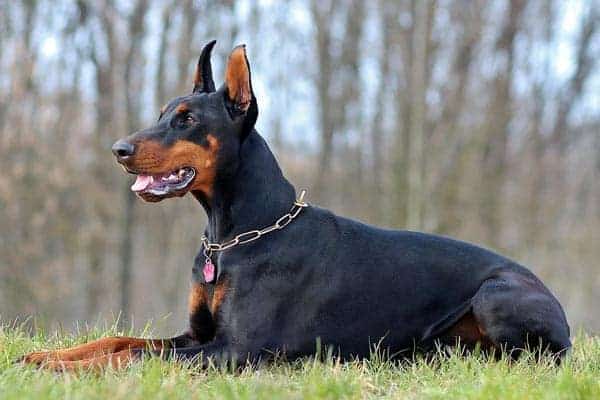
Doberman
Although you would probably never confuse a Dobie with a Rottie, you cannot ignore the striking similarities. Marked almost identically, the Doberman has a taller, more refined build with the same springy and efficient gait.
The two breeds are very similar in intelligence and share the qualities of courage, loyalty, guarding instinct, and working versatility.
A Dobie in the United States often has cropped ears that stand upright and docked tails. The Doberman’s natural ears and tails are very similar to the Rottweiler.
- Country of Origin: Germany
- History: In 1890, a tax collector Dobermann crossed many breeds, including the Rottweiler and Weimeraner, to create a protection dog with great stamina
- Size: 24 to 28 inches tall; Weighs 70 to 90 pounds
- Colors: Stereotypical pattern of rust or tan markings on a background of black, blue, fawn, or liver: White Dobermans exist
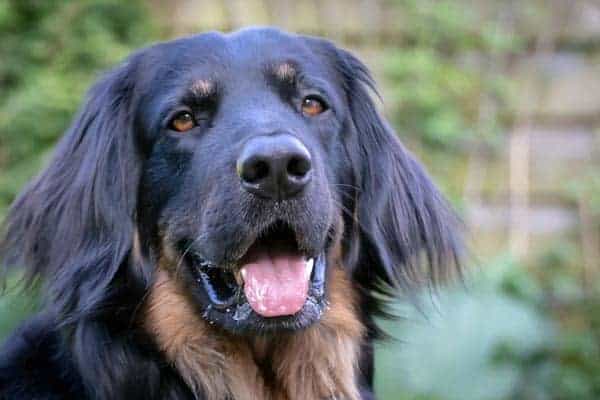
Hovawart
You have probably never heard of the Hovawart, but if there were such a thing as a long-haired Rottweiler, it would look like this dog. With relatively short-hanging ears, a bushy tail, and mahogany points, the Hovawart resembles a cross between a GSD and a Rottie.
Hovawarts are watchful, affectionate with family, and even-tempered. They have remained popular in Germany.
- Country of Origin: Germany
- History: A breed that has been around as early as the 1100s, these dogs were bred as livestock guardians; Restored several times with waning populations; Infusions with the Leonberger, Newfoundland, and Kuvasz
- Size: 23 to 29 inches tall; Weighs 55 to 115 pounds
- Colors: Solid black, black, and gold (Marked pattern similar to Rottie), or honey
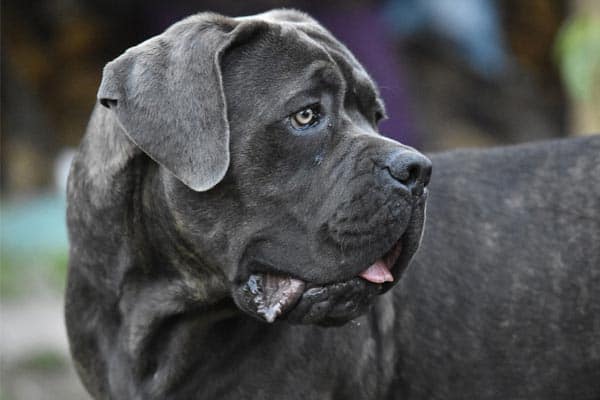
Cane Corso
A Cane Corso should strike you as bold, vibrant, and athletic. They often have the same intimidating intensity as Rottweilers. Though sporting colors other than black and tan, the Cane Corso resembles the Rottie in structure and mannerisms.
Cane Corsos are agile members of the Mastiff family. The breed is compact and powerfully built with an efficient gait. Ears are hanging or cropped very short, the head is relatively large, and the muzzle is slightly shortened.
- Country of Origin: Italy
- History: Ancestors were probably Roman war dogs; After 1453, the breed further developed to hunt boars and guard livestock, property, and people
- Size: 23 to 28 inches tall; 85 to 110 pounds
- Colors: Solid black or black brindle, red, fawn, gray
Other than color, the Cane Corso probably most closely resembles the Rottweiler in form.
Note the pronounced stop in the profile and each dog’s large but compact build. You can also see the athleticism and fluid movements of the dogs, similar to Rottweilers.
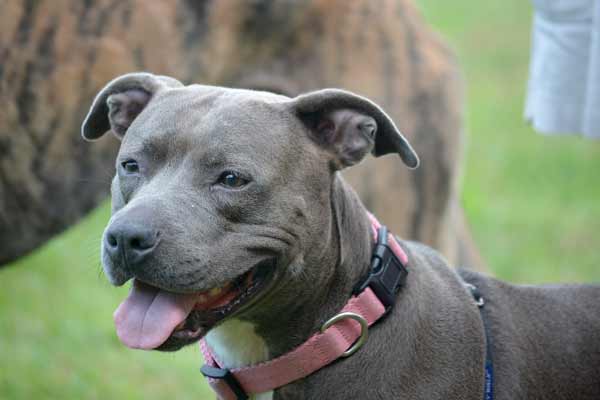
Pit Bull Terrier
The American Pit Bull Terrier is among the most popular pets in the US despite widespread bans and a formidable reputation. Easily trained and eager to please, the Pit Bull’s adaptability is one of its most excellent qualities.
The Pit Bull’s athletic and cat-like slinking gait distinguishes it from the Rottie, and most dogs are not black and tan.
However, of the bully breeds, they are most similar to the Rottweiler in their head structure, the ratio of muzzle to back skull, and ear position. The Pit Bull’s Impression is of power, friendliness, and stead nerves.
- Country of Origin: United Kingdom
- History: The animal cruelty ban of the 1830s led to the development of fighting dogs from Old English Bulldogs and Bull and Terriers; Pit Bulls were used in the “pits” against rats and, eventually, other dogs
- Size: 17 to 21 inches tall; 30 to 60 pounds; Some are bred much larger
- Colors: solid black, blue, or grey; fawn, red; Any color can have white
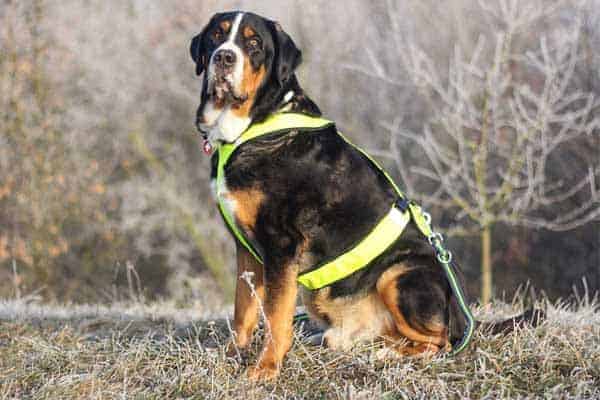
Greater Swiss Mountain Dog
The Greater Swiss Mountain Dog looks much like the Rottie, the notable difference being that the former is tricolor. However, the Swissie has a head shape and expression reminiscent of the Rottweiler.
Greater Swiss Mountain Dogs are large working dogs closely related to the Bernese Mountain Dog and St Bernard. Historians have learned that the Greater Swiss Mountain Dog is an old breed that has contributed to the development of many other dogs, including the Rottweiler. Its personality is confident, gentle, calm, and playful.
- Country of Origin: Switzerland
- History: Used to pull heavy carts in the 1500s and herd dairy cows; Also guarded livestock and people
- Size: 26 to 28 inches tall; weigh 100 to 150 pounds
- Color: Black and tan with white in a specific pattern
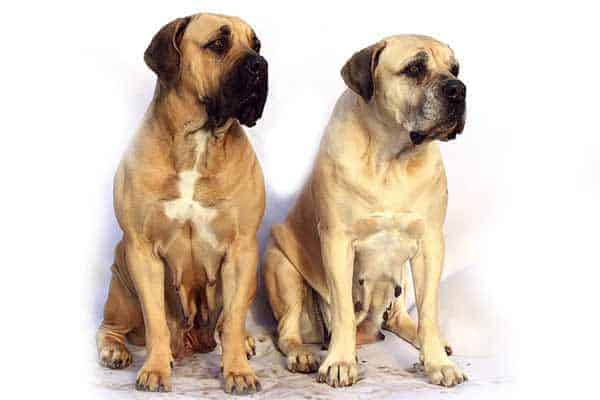
Mastiff Group
Dog owners commonly feel that many Mastiffs look like Rottweilers. Any resemblance makes sense because the Rottie’s ancestors belonged to the Molossoid group, which included war Mastiffs and some livestock guardians.
A few herding breeds, including ancient Rottweilers, emerged from the livestock working Molossoids.
Rotties are smaller than most mastiffs, have smaller heads, and have fewer folds around the face.
While Mastiffs were great for guarding and hunting, the Rottie’s smaller physique and excellent athleticism made it more versatile for herding and police and military work. Mastiffs are commonly dark but usually brindle as opposed to black and tan.
- Cane Corso – Italian breed already described
- Boxer – German working dog from the 1800s; Usually fawn or brindle, although some are all white; Boxers illustrates one of the significant differences between many Mastiff-types and Rotties, brachycephalic exaggeration; The Boxer muzzle-to-head length ratio is 1:3
- Bullmastiff – Bred in England in the 1800s; Temperament approaches that of the Rottie, combining Old English Bulldogs with less aggressive Mastiffs for hunting and guarding
- Boerboel – Developed in South Africa in the 1650s from European mastiff types as a guard and hunting dogs; They are not quick to attack without provocation and have evolved as livestock guardians against African predators; Usually shades of brown
- Great Dane – Only slightly resembles the Rottweiler, but scientists have determined it is the Rottie’s closest living relative; It Developed in the 1600s in Germany for hunting boars and guarding estates.
Mixed Breeds
If you have any experience with mixed-breed dogs from the shelter, you know that many resemble purebred dogs, including Rottweilers.
A good number of them are likely Rottweiler mixes that will resemble Rotties because of genetics. However, mixes of unrelated dogs can also produce a puppy resembling a Rottweiler.
- German Shepherd x Cane Corso
- Pit Bull x Black and Tan Coonhound
- Bernese Mountain Dog x GSD
Rottie mixes that often resemble purebreds are crosses with German Shepherds, Dobermans, Beaucerons, and Labrador Retrievers.
The dog in the middle of this video could pass as a Rottie with thick fur. The nose is slightly long for a Rottie, and the tail is bushy.
However, the curl and carriage of the tail are true to the Rottweiler breed. You can also see a subtle pattern variation of the black and tan across the shoulders, suggesting a GSD lineage.
